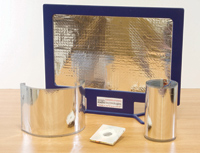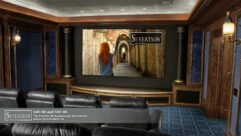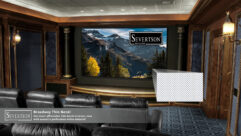

Thin Is In
Mar 21, 2010 5:53 PM,
By Scott Wilkinson
A new loudspeaker technology loses the bulk.
Warwick Audio Technologies’ Flat Flexible Loudspeaker can be formed into various shapes for different applications.
Loudspeaker technology has changed very little in nearly a century. Most loudspeakers today have one or more cone-shaped diaphragms attached to a coil of wire called the voice coil, which is placed near a permanent magnet. When an electrical audio signal passes through the voice coil, the current creates an alternating magnetic field that reacts to the permanent magnet’s static field, causing the voice coil—and thus the diaphragm—to move back and forth, reproducing the waveform embodied in the audio signal.
Related Links

It’s one thing to craft the finest sound reproduction in a controlled environment with the critical junction of hardware and acoustics–the loudspeaker system…

Until the past few years, technology advances in architectural loudspeakers were aimed primarily at the freestanding and exterior-mounted models where designers had a more free hand, but new materials and steerable tweeters have made their way into the ceiling loudspeaker market with impressive results…

Next month, the Themed Entertainment Association will celebrate the 16th annual THEA awards at Universal Studios, Hollywood, honoring 12 themed environment projects from across the globe. TEA President Steve Thorburn points out that the predominant theme this year is a maturation in the use of technology…
This design works very well, but it does have some shortcomings. For one thing, the diaphragms are relatively large, so they have a lot of inertia to overcome in order to start moving and change direction. Loudspeaker makers use materials that are as light as possible, but a coil of wire is bound to have a significant mass.
One solution to this problem is found in electrostatic loudspeakers (ESLs). Here, a superthin, extremely light electrically conductive diaphragm is stretched taut between two rigid, parallel, perforated metal plates called stators. The diaphragm is charged with a very high constant voltage, while the audio signal is fed to the stators, one out of phase with the other. As the current in the stators varies with the audio signal, the resulting electromagnetic fields push and pull the charged diaphragm.
Electrostatic diaphragms have low mass, and their excursion—:the distance they travel as they vibrate—is short, so they react much more quickly than cone diaphragms to any changes in the audio signal. However, these loudspeakers are generally quite large, and they require high voltages in semiexposed elements, which can be dangerous. Also, they can’t reproduce bass frequencies because they don’t move a lot of air.
Warwick Audio Technologies in Coventry, England, is working on an interesting variation of the electrostatic approach that does not require rigid stators, uses far less power, and can be formed into various sizes and shapes. Originally developed at the University of Warwick School of Engineering, the Flat Flexible Loudspeaker (FFL) is a laminated material with three layers: a solid, superthin conductive diaphragm; an insulating layer; and another conductive layer with a mesh-like structure. The layers are separated by tiny air gaps, and the entire sheet is only 0.25mm thick.
Like conventional ESLs, the diaphragm is charged with a static bias voltage, though it’s much lower and thus not dangerous. The audio signal is then superimposed onto the bias voltage in the diaphragm, and the same signal is applied with opposite polarity to the mesh layer, which is somewhat thicker than the diaphragm. As a result, the diaphragm vibrates according to the audio signal, while the somewhat thicker mesh layer remains relatively stationary and the insulating layer keeps them apart.
The frequency response is said to extend from 500Hz to 20kHz, and it can reach volume levels greater than 90dB SPL at a distance of 1 meter while consuming only 100mW to 200mW of power. Also, the volume falls off much more gradually than a cone-type loudspeaker as you get farther away, and the FFL’s directionality is much more controllable—in fact, it can be shaped into a parabola to focus the sound at a given location or curved outward to spread the sound evenly throughout the listening area.
The company envisions several applications for the FFL, including public-announcement systems, presentation spaces, and interactive educational and retail displays. This technology is not likely to replace conventional loudspeakers in professional or audiophile systems, but it holds great promise as an unobtrusive source of background music, especially where normal loudspeakers are impractical.
Scott Wilkinson is a contributing editor for EM, in which this article first appeared.










